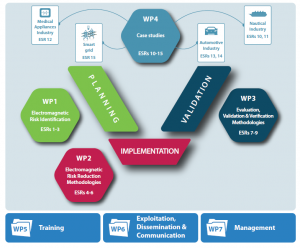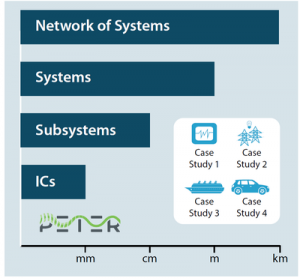The PETER project is split into different work packages (WPs). Each of the WPs is explained in more detail below. A complete overview with the beneficiaries and partners, can be found by clicking here.

WP1 : ELECTROMAGNETIC RISK IDENTIFICATION
Objectives
Develop methods to identify and analyse what the risks and hazards are related to electromagnetic disturbances impinging on modern, complex E/E/PE systems. Estimate how frequent and severe these disturbances might be and what the possible consequences are. These EMI-aware risk and hazard analyses start from both the system-under-development as well as its final electromagnetic environment.
ESR List
ESR1 – Statistic Electromagnetic Risk Analysis of Large and Complex Systems, Theoretical Description of Risk Assessment Methodologies
ESR2 – Statistic Electromagnetic Risk Analysis of Large and Complex Systems, Experimental Analysis and Model Verification
ESR3 – Risk-Based Automotive Electromagnetic Engineering Approach aligned with the ISO26262 Functional Safety Approach
WP2 : ELECTROMAGNETIC RISK REDUCTION METHODOLOGIES
Objectives
Provide an appropriate design process as well as mitigation techniques and measures that harden the system-under-development by design for the electromagnetic risks that are defined with the methods developed in WP1. This will allow engineers to select and adopt an optimally chosen set of risk reduction techniques (effectiveness, cost, complexity, etc.) that bring the “tolerability” of the electromagnetic risks “As Low As Reasonably Possible” (ALARP principle)
ESR List
ESR4 – Risk-Based EMI-Aware Design of Complex Systems
ESR5 – IEC 61508 Techniques & Measures for EMI Risk Reduction, Hardware-based Techniques & Measures
ESR6 – IEC 61508 Techniques & Measures for EMI Risk Reduction, Software-based Techniques & Measures
WP3 : EVALUATION, VALIDATION & VERIFICATION METHODOLOGIES
Objectives
Based on the EMI-aware risk-and-hazard analysis (WP1) the inherent weaknesses of the system-under-development as well as the most common threats from its operational environment are known and can be used to define a dedicated verification and validation plan to check whether the applied design techniques and measures (WP2) are appropriate. This test plan must go much further than traditional immunity standards, i.e., also taking into account ageing effects, environmental stresses, stochastic analysis, virtual testing, etc.
ESR List
ESR7 – Evaluation of Electromagnetic Hazards due to Environmental Stresses, Obsolescence and/or Ageing, Evaluation at the Integrated Circuit Level
ESR8 – Evaluation of Electromagnetic Hazards due to Environmental Stresses, Obsolescence and/or Ageing, Evaluation at the System Level
ESR9 – Statistic Verification and Validation of Immunity and Enclosure Shielding Effectiveness – Risk of Susceptibility
WP4 : CASE STUDIES

Objectives
Application of the complete electromagnetic risk-management approach (WP1, WP2 and WP3) to several industrial application case studies covering different application areas (maritime, automotive, medical and critical infrastructures) and design levels (from ICs to systems-of-systems).
ESR List
ESR10 – From Rule-Based Standards to Risk-Based, Cost-Effective, Up-to-Date, Maritime EMC Standards
ESR11 – Modelling and Reasoning about Electromagnetic Interactions in Autonomous and Complex Vessels
ESR12 – EMI-Resilient Medical Displays for Surgical-, Diagnostic Imaging- and Modality Applications
ESR13 – EMI Risk Management Applied to the Next Generation Vehicular Communication Devices
ESR14 – Risk-Based EMI-Aware Design of an Automotive Integrated Circuit
ESR15 – EMI Risk Management on the Scale of the Smart Grid as a Network of Systems
WP5 : TRAINING
Objectives
Create a European Doctoral/Graduate School for EMI Risk Management; Develop structural training programme for current and future generation of researchers/engineers active in Europe; Change the mind-set of EMC researchers and engineers from a rule-based to a risk-based approach.
WP6 : EXPLOITATION, DISSEMINATION & OUTREACH
Objectives
Disseminate the results of PETER to the academic, teaching, industrial and public communities in Europe. Establish and deploy a solid exploitation plan for future market introduction of Risk Based EMC.
WP7 : MANAGEMENT
Objectives
Successful and efficient project execution according the work plan, maintenance of relations between partners and ESRs, communication management and reporting.


